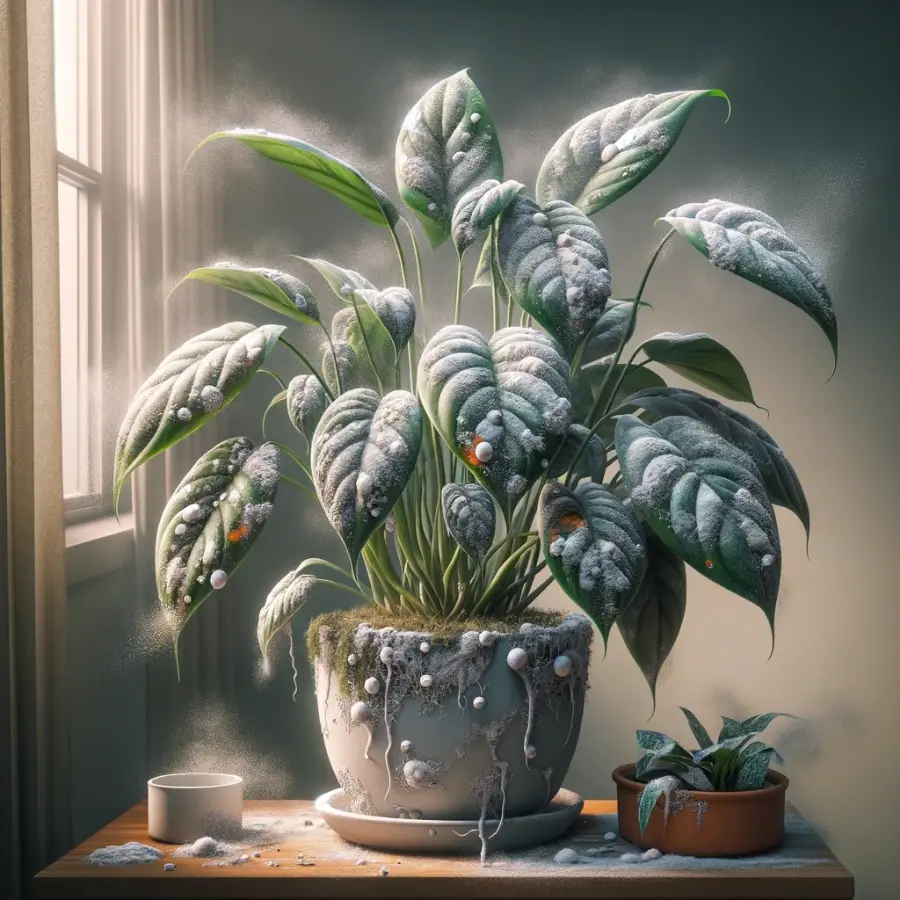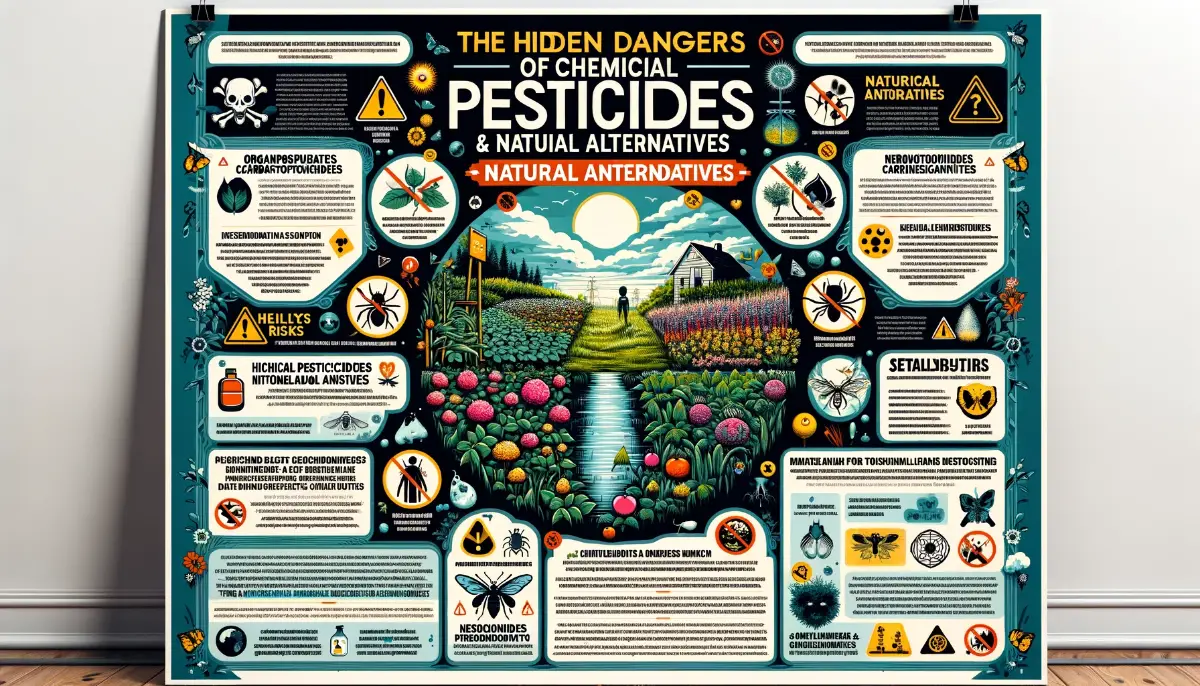Understanding powdery mildew involves recognizing its characteristics, causes, and the conditions that favor its growth. Powdery mildew is a fungal disease that affects a wide range of plants, manifesting as a white or gray powdery coating on the leaves, stems, and sometimes fruits of plants.
This mildew is caused by various fungal species, each of which tends to be specific to certain plant types, making it a common issue among both indoor and outdoor plants.
Characteristics
- Appearance: The most obvious sign of powdery mildew is its powdery, white to grayish coating that can appear on any above-ground part of the plant. It might initially form in small patches but can quickly cover the entire leaf surface.
- Impact on Plants: While not immediately lethal, powdery mildew can weaken plants. Affected leaves may turn yellow, brown, or become distorted, and the plant’s overall growth can be stunted.
Causes and Conditions
- High Humidity and Moderate Temperatures: Powdery mildew thrives in environments with high humidity combined with moderate temperatures, typical of many indoor environments.
- Poor Air Circulation: Limited airflow can exacerbate the conditions that allow powdery mildew spores to proliferate.
- Shade: Areas with low light levels can also be more prone to powdery mildew outbreaks.
How it Spreads
Powdery mildew spreads through airborne spores, which can be transported by wind, insects, and even humans moving from one plant to another. The spores require a living host to grow, which is why they target the green parts of plants.
Despite its preference for humid conditions on the plant’s surface, the spores themselves do not need water to germinate, which distinguishes powdery mildew from many other fungal diseases.
Organic Solutions for Powdery Mildew: Safe and Effective Remedies
Utilizing organic fungicides and homemade remedies can be a highly effective and environmentally friendly approach to combat powdery mildew on plants. Here’s how you can tackle this fungal issue using methods that are safe for both your plants and the environment:
Baking Soda Spray
A classic homemade remedy involves baking soda, which alters the pH on the leaf surface, making it less hospitable for powdery mildew to grow. Mix 1 tablespoon of baking soda with ½ teaspoon of liquid soap in 1 gallon of water. The liquid soap helps the solution adhere to the plant leaves. Spray this mixture on the affected areas thoroughly. While more effective as a preventive measure, it can also mitigate existing infections.
Related Article: Boost Your Houseplants with Baking Soda
Milk Spray
Surprisingly, milk has been found to help control powdery mildew. The exact mechanism is not fully understood, but it’s believed that milk’s natural compounds can boost the plant’s immune system. Mix 1 part milk with 2 to 3 parts water and spray on the plants. This method is especially popular for treating powdery mildew on cucumbers, zucchinis, and other squash plants.
Neem Oil
Neem oil is a natural fungicide that has been reported to control powdery mildew. Though it might have mixed effectiveness on its own, it can be added to other mixtures for an added boost. Neem oil works by disrupting the life cycle of the fungi, preventing spore germination and growth.
Potassium Bicarbonate
Similar to baking soda, potassium bicarbonate is a fungicide that can be used to treat powdery mildew. Mix 1 tablespoon of potassium bicarbonate with ½ teaspoon of liquid soap in 1 gallon of water and spray the affected plants. This mixture can be more effective than baking soda and is safe for organic gardening.
Sulfur-Based Fungicides
Sulfur is one of the oldest known fungicides and is very effective against powdery mildew. It works by creating an uninhabitable environment for the spores. Be cautious when applying sulfur, especially during hot weather, as it can burn the plants if applied when temperatures are above 90°F (32°C).
Application Tips
- Always test a small area of the plant first before applying any treatment widely, to ensure there is no adverse reaction.
- Apply treatments in the early morning or late afternoon to avoid burning the plants under the direct sun.
- Reapply treatments every 7 to 10 days, or as needed, to control the mildew.
Preventative Measures Against Powdery Mildew
Preventing powdery mildew from taking hold in the first place is far easier and more effective than trying to control it once it has spread. Here are some key preventative measures you can take to protect your indoor plants from this common fungal disease:
Optimize Environmental Conditions
- Light: Ensure your plants receive adequate light, as powdery mildew tends to thrive in lower light conditions. Position plants near windows or supplement with artificial lighting if necessary.
- Humidity and Airflow: Maintain moderate humidity levels and good air circulation around your plants. Use a dehumidifier if your indoor air is too humid and consider using fans to improve airflow. However, be careful not to place plants in direct drafts which can stress them.
- Temperature: Keep the indoor temperature consistent and avoid the cooler temperatures that powdery mildew spores favor.
Proper Plant Hygiene
- Sanitation: Regularly clean your plant leaves with a soft, damp cloth to remove dust and potential spores. Also, keep the area around your plants clean and free of plant debris.
- Disinfect Tools: Always disinfect pruning tools before and after use to prevent the spread of spores to other plants.
Watering Practices
- Water your plants in the morning so that any excess water on the foliage can evaporate throughout the day. Avoid overhead watering that leaves foliage wet for extended periods, as this can create an ideal environment for powdery mildew growth.
Plant Selection and Spacing
- Resistant Varieties: Whenever possible, choose plant varieties that are resistant to powdery mildew. Many breeders have developed resistant varieties of popular plants.
- Proper Spacing: Ensure plants are spaced adequately to allow for air circulation between them. Crowded plants create a microclimate that powdery mildew loves.
Regular Monitoring and Early Intervention
- Keep a close eye on your plants, especially those that have been previously affected or are known to be susceptible to powdery mildew. At the first sign of infection, isolate the affected plant and begin treatment immediately to prevent the spread to other plants.
Preventive Spraying
- Consider using organic preventive sprays, such as a diluted solution of baking soda and water or milk and water, on plants that are prone to powdery mildew. These can alter the pH of the leaf surface, making it less inviting for spores to germinate.
Implementing these preventative measures can greatly reduce the risk of powdery mildew infestation in your indoor garden. By creating an environment that is less conducive to the growth and spread of this fungus, you can enjoy healthier plants and a more vibrant indoor garden.
FAQs about Powdery Mildew on Indoor Plants
What is powdery mildew?
Powdery mildew is a fungal disease that affects a wide variety of plants, manifesting as a white or gray powdery substance on the leaves and stems. It thrives in warm, dry climates with high humidity.
How does powdery mildew spread?
Powdery mildew spreads through microscopic spores carried by wind, insects, or even human interaction with the plants. It can quickly infect nearby plants under favorable conditions.
Can powdery mildew harm my indoor plants?
Yes, while powdery mildew primarily affects the aesthetic value of the plant, severe infections can lead to yellowed leaves, stunted growth, and even plant death.
Are some indoor plants more susceptible to powdery mildew than others?
Yes, certain plants like African violets, begonias, and many ornamentals are more prone to powdery mildew due to their preferred growing conditions, which can align with the fungus’s needs.
How can I prevent powdery mildew on my indoor plants?
Preventive measures include providing adequate air circulation, avoiding overhead watering, maintaining optimal humidity levels, and ensuring plants receive enough light. Resistant plant varieties can also help reduce the risk.
Can powdery mildew spread from indoor plants to outdoor plants?
While possible, it’s less likely unless outdoor plants are brought indoors or vice versa. The spores need specific conditions to thrive and spread, which can differ significantly between indoor and outdoor environments.
How do I treat powdery mildew organically?
Organic treatments include spraying affected plants with a baking soda and water mixture, applying neem oil, or using milk sprays. These methods can help control and prevent further spread of the disease.
Is it safe to use vinegar to treat powdery mildew?
Vinegar can be used in a diluted form as a fungicide due to its acetic acid content. However, it should be applied cautiously as it can harm the plant if used too concentrated or too frequently.
Can I still eat fruits and vegetables from plants with powdery mildew?
Yes, fruits and vegetables from plants affected by powdery mildew are generally safe to eat after washing. However, the disease may affect the quality and yield of the produce.
When should I throw away a plant infected with powdery mildew?
If a plant is severely infected and not responding to treatments, or if it’s continually infecting other plants, it might be best to remove and dispose of it to protect the rest of your indoor garden.









